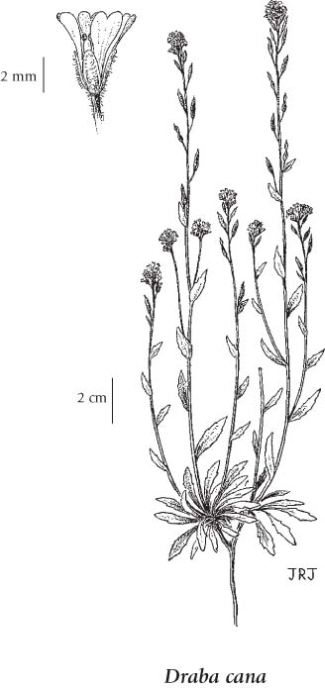Draba cana Rydb.
lance-leaved draba (hoary draba; lance-leaved whitlow-grass)
Brassicaceae (Mustard family)
Introduction to Vascular Plants
lance-leaved draba (hoary draba; lance-leaved whitlow-grass)
Brassicaceae (Mustard family)
Introduction to Vascular Plants
Species Information
General:
Loosely tufted perennial herb from a taproot and a simple or branched stem-base; stems branched, erect or decumbent at base, 5-25 cm tall, densely hairy with simple and starlike hairs.
Leaves:
Basal leaves oblanceolate, 1-4 cm long, 1-4 mm wide, usually toothed; stem leaves (3) 5-8 (12), lanceolate, commonly toothed; densely hairy with simple or branched hairs, generally starlike with branches again branched.
Flowers:
Racemes several- to many-flowered, less than 60, usually some in leaf axils; flower stalks 2-9 mm long, appressed, erect, hairy, lower ones often bracted and less than 3 mm; petals white, 3-5 mm long; sepals 1.5-2 mm long, sparsely soft-hairy.
Fruits:
Silicles, 4-12 mm long, 1.5-2.5 mm wide, lanceolate to oblong, commonly twisted; usually densely soft-hairy, the hairs less than 3-branched and also starlike; styles 0.2-0.8 mm long; fruiting racemes usually occupying the top half of the stems.
Illustration

If more than one illustration is available for a species (e.g., separate illustrations were provided for two subspecies) then links to the separate images will be provided below. Note that individual subspecies or varietal illustrations are not always available.
Illustration Source: The Illustrated Flora of British Columbia
Ecology
Ecological Framework for Draba cana
The table below shows the species-specific information calculated from
original data (BEC database) provided by the BC Ministry of Forests and Range.
(Updated August, 2013)
The table below shows the species-specific information calculated from
original data (BEC database) provided by the BC Ministry of Forests and Range.
(Updated August, 2013)
| Site Information |
Value / Class |
||
|
Avg |
Min |
Max |
|
| Elevation
(metres) |
2034 | 1685 | 2610 |
| Slope
Gradient (%) |
34 | 3 | 80 |
|
Aspect (degrees) |
74 | 20 | 270 |
| Soil
Moisture Regime (SMR) [0 - very xeric; 4 - mesic; 8 - hydric] |
2 | 0 | 4 |
| Modal
Nutrient Regime
Class |
C | ||
| #
of field plots species was recorded in: |
7 | ||
| Modal
BEC Zone Class |
ESSF | ||
|
All BEC Zones (# of stations/zone) species was recorded in |
AT(1), ESSF(3) | ||
|
Source:
Klinkenberg 2013
|
|||